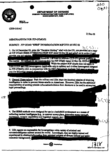National intranet
This article may need to be rewritten to comply with Wikipedia's quality standards. (March 2021) |
A national intranet is an Internet protocol-based walled garden network maintained by a nation state as a national substitute for the global Internet, with the aim of controlling and monitoring the communications of its inhabitants, as well as restricting their access to outside media.[1] Other names have been used, such as the use of the term "halal internet" in Islamic countries.
Such networks generally come with access to state-controlled media and national alternatives to foreign-run Internet services: search engines, web-based email, and so forth.[2]
List of countries with national intranets[]
Myanmar[]
Burma before 2011 used to have a separate intranet for domestic use called Myanmar Wide Web.[3]
Cuba[]
Cuba has its own state controlled intranet called national web.[4][5][6][7]
United States[]
In 2020 USDOE unveiled a blueprint for creating a .[8][9]
North Korea[]
North Korea's Kwangmyong network, dating back to 2000, is the best-known of this type of network. Cuba and Myanmar also use a similar network system that is separated from the rest of the Internet.[10] The network uses domain names under the .kp top level domain that are not accessible from the global Internet.[11] As of 2016 the network uses IPv4 addresses reserved for private networks in the 10.0.0.0/8 range.[11]
Russia[]
In 2020 Russia tested internal internet known as RuNet (Internet in Russian Federation territory).[12]
China[]
This article is written like a personal reflection, personal essay, or argumentative essay that states a Wikipedia editor's personal feelings or presents an original argument about a topic. (April 2021) |
A primary insight flows from our research and it pertains to the stability of China’s internet: the internet in China is a walled garden in terms of structure yet at the same time dependent upon Western Europe and the United States for foreign connectivity.[13][14][15] Put plainly, in terms of resilience, China could effectively withdraw from the global public internet and maintain domestic connectivity (essentially having an intranet).[16][17][18] This means the rest of the world could be restricted from connecting into China, and vice versa for external connections for Chinese businesses/users.[19][20][21]
Iran[]
The National Information Network of Iran works like the Great Firewall of China.[22][23][24] In April 2011, a senior Iranian official, Ali Agha-Mohammadi announced government plans to launch its own "halal internet", which would conform to Islamic values and provide "appropriate" services.[25] Creating such a network, similar to the North Korean example, would prevent unwanted information from outside Iran getting into the closed system.[10] The Iranian walled garden would have its own localized email service and search engine.[26]
See also[]
- Internet censorship by country
- Intranet
- Surveillance state
- Splinternet
References[]
- ^ "The Great Firewall of China". Bloomberg.com. Retrieved 2021-02-21.
- ^ "Putin brings China's Great Firewall to Russia in cybersecurity pact". the Guardian. 2016-11-29. Retrieved 2021-02-21.
- ^ Deibert, Ronald; Palfrey, John; Rohozinski, Rafal; Zittrain, Jonathan (2008-01-25). Access Denied: The Practice and Policy of Global Internet Filtering. MIT Press. ISBN 978-0-262-29072-2.
- ^ Scola, Nancy. "Wait, Cuba has its own Internet?". Washington Post. ISSN 0190-8286. Retrieved 2021-03-20.
- ^ "Cuba - The World Factbook". www.cia.gov. Retrieved 2021-03-20.
- ^ "More Cubans have local intranet, mobile phones". Reuters. Retrieved 2021-03-20.
- ^ Sep 6, Harrison Jacobs; 2018; Pm, 12:49. "Is there internet in Cuba?". Business Insider. Retrieved 2021-03-20.CS1 maint: numeric names: authors list (link)
- ^ Reichert, Corinne. "The US wants to develop a quantum internet". CNET. Retrieved 2021-03-20.
- ^ "From Long-distance Entanglement to Building a Nationwide Quantum Internet: Report of the DOE Quantum Internet Blueprint Workshop". 2020-02-05. Cite journal requires
|journal=(help) - ^ a b Christopher Rhoads and Farnaz Fassihi (May 28, 2011). "Iran Vows to Unplug Internet". Wall Street Journal. Retrieved 2012-09-24.
- ^ a b Mäkeläinen, Mika (14 May 2016). "Yle Pohjois-Koreassa: Kurkista suljetun maan omaan tietoverkkoon" [Yle in North Korea: Peek into the Network of the Closed Country] (in Finnish). Yle]. Retrieved 15 May 2016.
- ^ "Russia Takes a Big Step Toward Internet Isolation". Wired. ISSN 1059-1028. Retrieved 2021-03-20.
- ^ Denyer, Simon (2016-05-23). "China's scary lesson to the world: Censoring the Internet works". Washington Post. ISSN 0190-8286. Retrieved 2021-02-21.
- ^ Chao, Loretta (2010-12-21). "'Father' of China's Great Firewall Shouted Off Own Microblog". Wall Street Journal. ISSN 0099-9660. Retrieved 2021-02-21.
- ^ Martina, Paul Carsten, Michael (2016-04-08). "U.S. says China internet censorship a burden for businesses". Reuters. Retrieved 2021-02-21.
- ^ "How China's Internet Police Control Speech on the Internet". Radio Free Asia. Retrieved 2021-02-21.
- ^ Siegel, Rachel. "Search result not found: China bans Wikipedia in all languages". Washington Post. ISSN 0190-8286. Retrieved 2021-02-21.
- ^ "TLS certificate blunder revisited – whither China Internet Network Information Center?". Naked Security. 2015-04-14. Retrieved 2021-02-21.
- ^ Dave Allen (July 19, 2019). "Analysis by Oracle Internet Intelligence Highlights China's Unique Approach to Connecting to the Global Internet". Oracle. Retrieved 2020-07-30.
- ^ Mozur, Paul (2015-09-14). "Baidu and CloudFlare Boost Users Over China's Great Firewall (Published 2015)". The New York Times. ISSN 0362-4331. Retrieved 2021-02-21.
- ^ "How China's social media users created a new language to beat censorship on COVID-19". www.amnesty.org. Retrieved 2021-02-21.
- ^ "Iran To Work With China To Create National Internet System". www.rferl.org. Retrieved 2021-02-21.
- ^ Refugees, United Nations High Commissioner for. "Refworld | Freedom on the Net 2018 - Iran". Refworld. Retrieved 2021-02-21.
- ^ "What You Need to Know about Internet Censorship in Iran". Centre for International Governance Innovation. Retrieved 2021-02-21.
- ^ "Iran clamps down on Internet use", Saeed Kamali Dehghan, The Guardian, 5 January 2012
- ^ Ryan Paul (April 10, 2012). "Iran moving ahead with plans for national intranet". Ars Technica. Retrieved 2012-09-24.
- Internet censorship
- Mass surveillance
